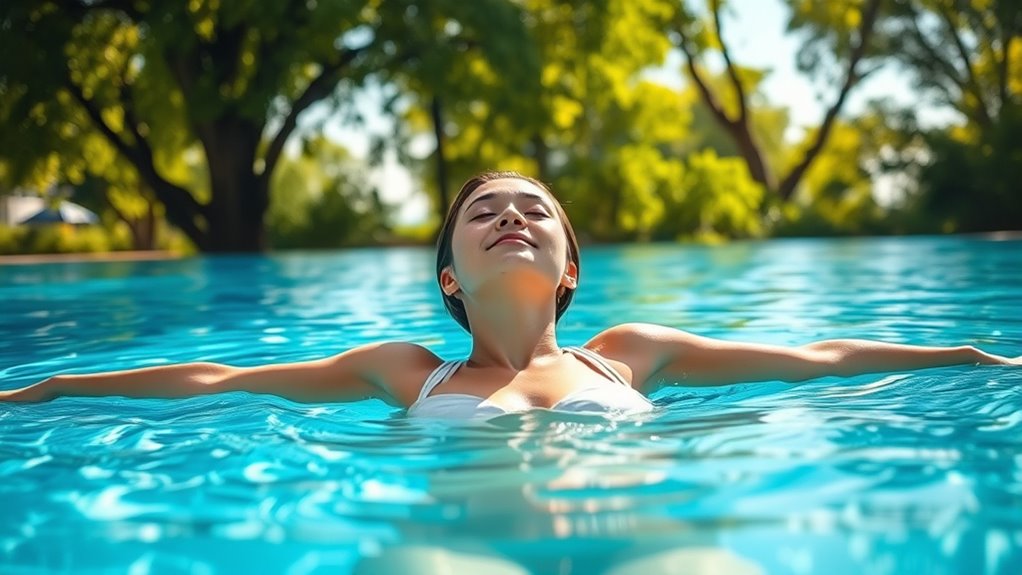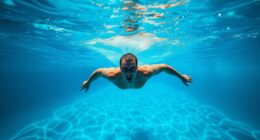To do gentle water exercises while floating, find a safe, shallow area and support your back to relax. Incorporate slow leg lifts and alternating arm circles to engage muscles without strain. Focus on deep, calming breathing to enhance relaxation. Use buoyancy to ease movement and reduce joint stress. Keep movements controlled and gentle. If you keep exploring, you’ll discover more tips to maximize your water workout experience.
Key Takeaways
- Support your back in shallow water to float comfortably and maintain proper posture during exercises.
- Use slow, controlled movements like leg lifts and arm circles to engage muscles gently.
- Incorporate deep breathing techniques to promote relaxation and enhance oxygen flow.
- Focus on gentle, deliberate motions to avoid overexertion and ensure safety.
- Combine floating with light resistance exercises or classes tailored for low-impact, gentle activity.

If you’re looking for a low-impact way to stay active, gentle water exercises are an excellent option. Floating adds an element of relaxation and support, making these exercises accessible even if you’re new to fitness or recovering from injury. One of the most effective ways to engage in gentle water exercises is through aquatic therapy, which leverages the natural buoyancy of water to reduce joint stress while improving strength and flexibility. Water aerobics, on the other hand, offers a fun, social way to get your heart rate up without putting too much strain on your body. Combining floating with these exercise styles allows you to maximize comfort and effectiveness, especially if you’re dealing with arthritis, muscle pain, or balance issues.
Start by finding a safe, shallow area where you can comfortably float with your back supported by the water. Once you’re floating, focus on slow, controlled movements that work your muscles without overexerting yourself. For example, gentle leg lifts can help strengthen your lower body. Simply lift one leg slightly off the water, hold for a few seconds, then lower it back down. Repeat with the other leg. This not only helps build strength but also enhances your stability. You can also do arm circles by extending your arms to the sides and making slow, deliberate circles. This movement engages your shoulder muscles while keeping the resistance light and manageable. Because you’re floating, you naturally have less gravity’s influence, making these motions easier and safer. Additionally, incorporating proper breathing techniques can further enhance relaxation and oxygen flow during your exercises.
Incorporate breathing exercises while floating to enhance relaxation and oxygen flow. Breathe deeply through your nose, filling your lungs completely, then exhale slowly through your mouth. This deep breathing can calm your nervous system, reduce stress, and improve your overall sense of well-being. If you want to add a bit more intensity, try water aerobics routines designed for gentle movement. Many pools offer classes specifically for seniors or those with limited mobility, emphasizing slow-paced, rhythmic exercises that promote circulation and joint flexibility. These classes often include floating segments or exercises that involve minimal impact but significant benefits.
Frequently Asked Questions
Can Beginners Safely Try Water Exercises Without Prior Experience?
Yes, you can safely try water exercises as a beginner by focusing on water safety and beginner techniques. Make sure to stay in shallow areas and use floatation devices if needed. Start slow, listen to your body, and avoid overexertion. It’s also helpful to have a trained instructor guide you through proper techniques, ensuring you build confidence while minimizing the risk of injury.
How Long Should Each Water Exercise Session Last?
Experts suggest keeping each water exercise session around 20 to 30 minutes, as this duration maximizes benefits without causing fatigue. You should aim for 3 to 5 sessions weekly, allowing your muscles time to recover. Shorter, consistent sessions often prove more effective than infrequent, lengthy workouts. Stick to these duration guidelines and session frequency to safely enjoy gentle water exercises while floating, enhancing your strength and flexibility over time.
Are There Specific Water Temperatures Recommended for Gentle Exercises?
You should aim for a water temperature between 83°F and 88°F for gentle exercises, as it promotes comfort and exercise safety. Cooler water might cause muscle stiffness, while warmer water can lead to overheating. Maintaining this temperature range helps you stay relaxed and safe during your workout. Always listen to your body and adjust the water temperature if you feel discomfort, ensuring a safe and effective exercise session.
Can Water Exercises Help With Joint Pain or Arthritis?
Imagine easing through water like a gentle breeze—water exercises can indeed help with joint pain and arthritis relief. They boost joint flexibility, reduce stiffness, and minimize impact on your joints. By engaging in gentle movements, you’ll find relief from discomfort and improve your mobility. Regular water exercises create a soothing, supportive environment that encourages healing and strength, making everyday activities easier and more comfortable for you.
Is Special Equipment Needed for Floating Water Exercises?
You don’t need special equipment for floating water exercises; water buoyancy naturally supports your body, making movements easier. However, floating aids like kickboards or noodles can enhance stability and confidence, especially if you’re a beginner. These aids help maintain proper posture and prevent fatigue. Using floating aids is optional but beneficial, ensuring you stay comfortable and safe while enjoying gentle water exercises that reduce joint strain and promote relaxation.
Conclusion
Now that you know how to do gentle water exercises while floating, you’ll feel like a weightless feather gliding effortlessly through the water. These exercises can transform your routine into a soothing escape, easing stress and boosting your mood. Stick with it, and you’ll discover a level of relaxation so profound, it’s almost like floating on a cloud made of serenity. Immerse yourself and let the water work its magic—your body will thank you for it!









